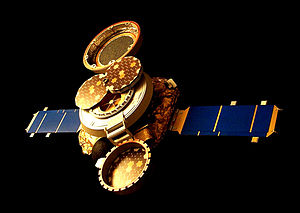 In its collecting configuration, the Genesis spacecraft exposed several types of solar wind collectors, as well as ion and electron monitors. | |
| Mission type | Sample-return mission |
|---|---|
| Operator | NASA · JPL |
| COSPAR ID | 2001-034A |
| SATCAT no. | 26884 |
| Website | genesismission |
| Mission duration | 3 years, 30 days, 23 hours, 44 minutes[1] |
| Spacecraft properties | |
| Manufacturer | Lockheed Martin Space Systems |
| Launch mass | 636 kg (1,402 lb)[2] |
| Dry mass | 494 kg (1,089 lb)[3] |
| Dimensions | 2.3 × 2.0 m (7.5 × 6.6 ft)[3] |
| Power | 254 W (solar array / NiH2 battery)[3] |
| Start of mission | |
| Launch date | August 8, 2001, 16:13:40 UTC[2] (23 years, 3 months, 17 days ago) |
| Rocket | Delta II 7326-9.5 (D287)[2] |
| Launch site | Cape Canaveral SLC-17A[2] |
| Contractor | Boeing |
| End of mission | |
| Landing date | September 8, 2004, 15:58 UTC[2] (20 years, 2 months, 17 days ago) |
| Landing site | Dugway Proving Ground, Utah 40°11′19″N 113°12′46″W / 40.18861°N 113.21278°W |
 Official insignia for the Genesis mission | |
Genesis was a NASA sample-return probe that collected a sample of solar wind particles and returned them to Earth for analysis. It was the first NASA sample-return mission to return material since the Apollo program, and the first to return material from beyond the orbit of the Moon.[4][5] Genesis was launched on August 8, 2001, and the sample return capsule crash-landed in Utah on September 8, 2004, after a design flaw prevented the deployment of its drogue parachute. The crash contaminated many of the sample collectors. Although most were damaged, some of the collectors were successfully recovered.[6]
The Genesis science team demonstrated that some of the contamination could be removed or avoided, and that the solar wind particles could be analyzed using a variety of approaches, achieving all of the mission's major science objectives.[7][8]
- ^ "Genesis: In Depth". NASA Solar System Exploration. Retrieved September 25, 2023.
- ^ a b c d e "Genesis: In Depth". NASA Solar System Exploration. Retrieved February 2, 2020.
- ^ a b c "Genesis". NASA Space Science Data Coordinated Archive. Retrieved February 2, 2020.
- ^ Siddiqi, Asif A. (2018). Beyond Earth: A Chronicle of Deep Space Exploration, 1958–2016 (PDF). The NASA history series (2nd ed.). Washington, DC: NASA History Program Office. p. 2. ISBN 9781626830424. LCCN 2017059404. SP2018-4041.
- ^ The NASA Stardust mission launched two years before Genesis, but did not return to Earth until two years after Genesis's return.
- ^ "Genesis Solar Wind Samples". Curation Series. NASA/JPL.
- ^ Reisenfeld, Daniel B.; et al. (June 2013). "Solar Wind Conditions and Composition During the Genesis Mission as Measured by in situ Spacecraft". Space Science Reviews. 175 (1–4): 125–164. Bibcode:2013SSRv..175..125R. doi:10.1007/s11214-013-9960-2. S2CID 120682800.
- ^ "Genesis Science Team". NASA/JPL.